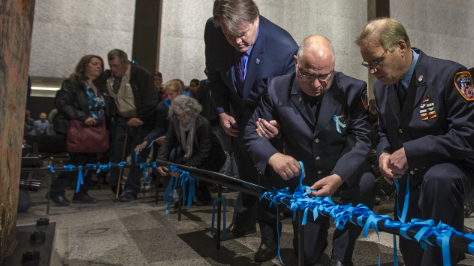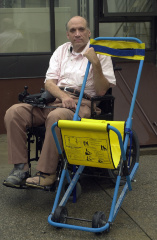Rescue & Recovery: In Their Own Voices with Gary Smiley
Rescue & Recovery: In Their Own Voices with Gary Smiley
- August 1, 2022

To highlight the diversity and previously unimaginable undertaking of the 9/11 rescue and recovery community, we've created the ongoing Q&A series "In Their Own Voices." This installment features Gary Smiley, an FDNY paramedic on 9/11.
Where were you on 9/11?
I was working overtime with the New York City Fire Department as a paramedic. It was my buddy’s birthday, so I took his morning shift before I was supposed to work in the afternoon. I was stationed in lower Brooklyn, and when the first plane hit the North Tower, I was at the firehouse, at the base of Manhattan Bridge.
I was on a specialty unit as a hazardous materials paramedic, and I’d been with FDNY for 16 years. We would typically listen to the special operations divisions radio of the NYPD. We heard a police officer screaming that a plane had hit the World Trade Center. I remember going over the Brooklyn Bridge, and you could already see the plume of smoke coming out of the North Tower, and I looked at the guy that was sitting next to me, and said, “That’s not a small plane.”
I was there in 1993 for the first attack on the World Trade Center site, so it was a flashback to seeing thousands of people in the streets with blackened faces. On the morning of September 11th, people were fleeing and when we arrived, there were already people who were on the street and injured. I was one of the senior guys there, so I told everyone, “Go to the far side of the street, set up triage, and start bringing these injured people there.” A woman had come out of the atrium, and she was horrifically injured. She was stumbling. I grabbed her, picked her up, and started carrying her across Church Street Within about 10 seconds she was screaming, “Plane, plane, plane!” I said to her, “Yeah, a plane hit the building.” What I didn’t realize was that she saw the second plane. I felt the explosion and the jet fuel. I threw her on the ground, and I threw myself on top of her, and that’s when I got burned on my back.
I made my way to West Street, that is the pre-planned staging area for any incident at the World Trade Center complex for the FDNY. That’s where it was in ’93. We parked and joined about 50 FDNY members waiting for orders. They said, “We need paramedics for triage in the lobby of the South Tower.” We started walking down West Street, and that’s when we saw everybody running towards us as the South Tower started to collapse. I ended up in the lobby of the American Express building in the atrium and then the radios started working again.
I heard my two buddies that were on another unit, issuing a mayday they were trapped. I had no idea where they were, but I had to go find them. I gathered up a portable stretcher and my medical bag. At that point West Street was a pile of rubble. I made it to the north pedestrian bridge when I heard a crack. It was the antenna of the North Tower as the building came down. I had maybe half a second to start running. The implosion of the building blew me down West Street and underneath one of the vehicles. I was shielded from most of the building debris, but the ambulance ended up squishing me.
A few hours later, I started digging myself out when I woke up. I didn’t realize how injured I was at the time. Another firefighter had self-extricated himself, and we found each other, and we made our way out of the collapse zone to a deli. There were dozens of cops and firefighters and paramedics, and everybody was caked in concrete. It was in your mouth, it was in your eyes, you couldn’t breathe. It was hot, our skin was burnt, every part of exposed skin was burnt.
I ended up having crush syndrome. The ambulance that I was under was squishing me from the waist down. The lower part of my body was not getting much oxygen because it wasn’t getting blood flow. When you take the weight off, that blood flow returns to the rest of the body. Since it hasn’t been oxygenated, it has a lot of lactic acid in it, and it causes organ failure. My organs began to fail later in the evening. At around 10 o’clock at night, I collapsed. I was in complete kidney failure. I was rushed to the Long Island College Hospital and they saved my life.
What role did you play in the rescue, recovery, and relief efforts?
After I was discharged a week later, I wanted to go back to the Trade Center the next day, but because of my injuries, the job wouldn’t allow it. I was put on "candle duty" - monitoring the stations in downtown Brooklyn because people were dropping off so many candles to pay their respects. I met with firefighters and EMTs, and we would just cry, because so many of their colleagues – friends and family - were missing. Two of the guys from my station were missing. Around the beginning of October, I was cleared to go back to work and was assigned to the Trade Center. I was assigned as relief for paramedics and EMTs ensuring we were always available to assist. Often, we were administering IVs and taking care of the injured. I was there for 480 hours.
Can you describe the bond you feel with other recovery workers? How has this community impacted you?
I was lucky enough to be part of an initial survivor’s group. To this day, I am friends with dozens of them. There are a few guys that I was with that day, and we speak weekly. We don’t talk about it much. We talk about other stuff. My friends from the FDNY don’t talk about it a lot, but we do our best to make sure we help the men and women that are very sick from 9/11. We really fight very hard for them and that's how we spend a lot of our time. It keeps us busy, keeps us attached to jobs – to the jobs that we had.
Many of us got involved in the 9/11 community later. For me, it was becoming an advocate by working with the Feal Good Foundation and spending dozens of hours down in Washington, D.C. Then, when the 9/11 Memorial Museum started the Docent program, I was asked to be in the first Docent class – it was such an honor. As we say in the FDNY, if you talk about somebody, their memory never dies. I was able to share my thoughts about my friend James Coyle, whose truck (Ladder 3) sits in the Museum. I also got involved with an organization called Strength to Strength. It is made up of survivors of terrorism from around the world. The individuals involved represent 30 years of terrorist attacks.
Do you have any health issues connected to your time at Ground Zero?
I was sick early on. I had a cough. I was diagnosed with asthma in early 2002. In 2006, I had major reconstructive surgery of my sinus. I’ve had about 12 surgical procedures since then. I have sinusitis, asthma, and reactive airway disease. A lot of us battled through what we needed to do as much as we could, until we couldn’t do it anymore. I retired from the FDNY in 2012. I spent 27 years on the job and I could no longer work. I have some damage to my pancreas and one of my damaged kidneys caused a type of diabetes, and yet I still feel pretty fortunate. I’m on top of my health. I have good days and bad. You make the best of it because tomorrow is not promised.
Why is it important to share 9/11 stories with the generation growing up with no memory of September 11th?
It is important for them to know what happened and how brave everyone was on 9/11 and continue to be brave fighting for their lives with illnesses. We don’t like being called heroes, and I don’t ever call myself one, but heroism is not confined to somebody wearing a uniform. Anybody can be heroic.
Compiled by Caitlyn Best, Government and Community Affairs Coordinator
Previous Post
Disability Pride Month: Two-Time Survivor John Abruzzo

Winding down Disability Pride Month, we're sharing the story of Port Authority associate accountant John Abruzzo, who, on 9/11, brought his newly customized power wheelchair to work on the North Tower's 69th floor. But it was a much simpler device - and loyal co-workers - that would ultimately save his life that day.
Next Post
Alice M. Greenwald Statement on the Killing of Ayman Al-Zawahiri

A statement from Alice M. Greenwald, President and CEO of the National September 11 Memorial & Museum, on the killing of top al Qaeda leader Ayman Al-Zawahiri.